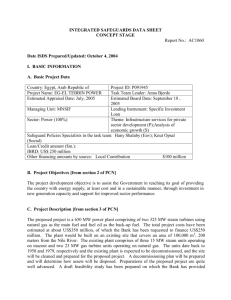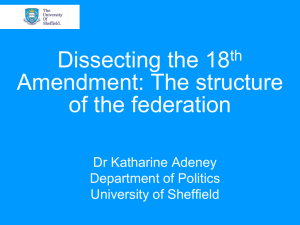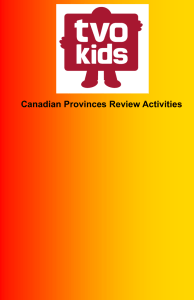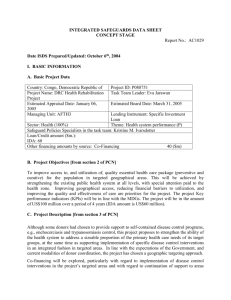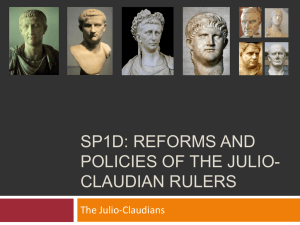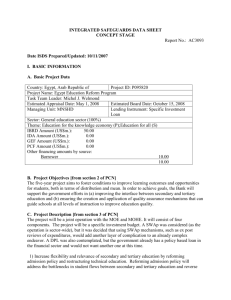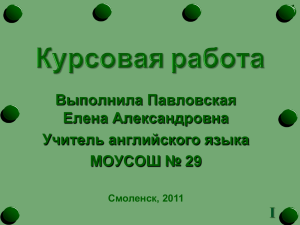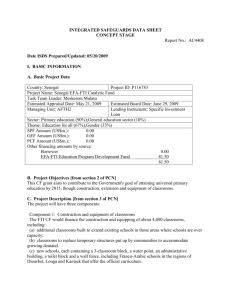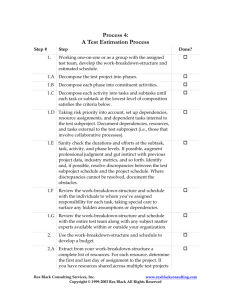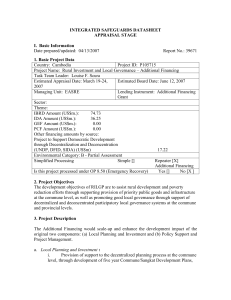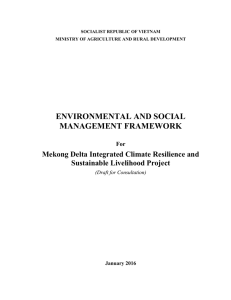Integrated Safeguards Data Sheet
advertisement
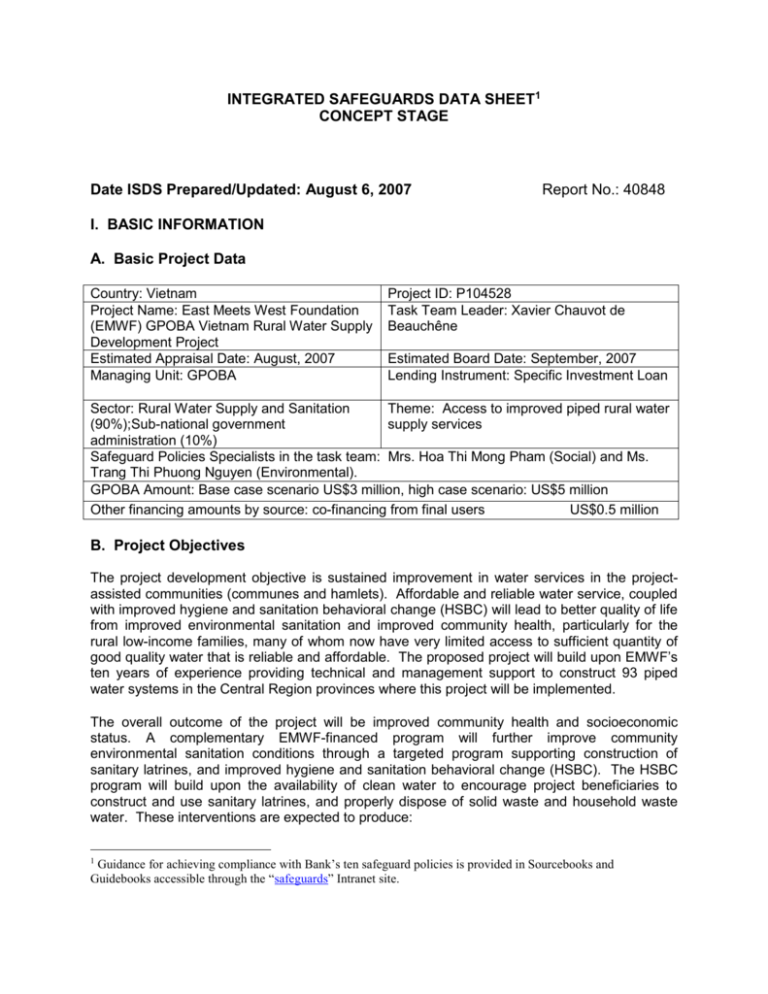
INTEGRATED SAFEGUARDS DATA SHEET1 CONCEPT STAGE Date ISDS Prepared/Updated: August 6, 2007 Report No.: 40848 I. BASIC INFORMATION A. Basic Project Data Country: Vietnam Project Name: East Meets West Foundation (EMWF) GPOBA Vietnam Rural Water Supply Development Project Estimated Appraisal Date: August, 2007 Managing Unit: GPOBA Project ID: P104528 Task Team Leader: Xavier Chauvot de Beauchêne Estimated Board Date: September, 2007 Lending Instrument: Specific Investment Loan Sector: Rural Water Supply and Sanitation Theme: Access to improved piped rural water (90%);Sub-national government supply services administration (10%) Safeguard Policies Specialists in the task team: Mrs. Hoa Thi Mong Pham (Social) and Ms. Trang Thi Phuong Nguyen (Environmental). GPOBA Amount: Base case scenario US$3 million, high case scenario: US$5 million Other financing amounts by source: co-financing from final users US$0.5 million B. Project Objectives The project development objective is sustained improvement in water services in the projectassisted communities (communes and hamlets). Affordable and reliable water service, coupled with improved hygiene and sanitation behavioral change (HSBC) will lead to better quality of life from improved environmental sanitation and improved community health, particularly for the rural low-income families, many of whom now have very limited access to sufficient quantity of good quality water that is reliable and affordable. The proposed project will build upon EMWF’s ten years of experience providing technical and management support to construct 93 piped water systems in the Central Region provinces where this project will be implemented. The overall outcome of the project will be improved community health and socioeconomic status. A complementary EMWF-financed program will further improve community environmental sanitation conditions through a targeted program supporting construction of sanitary latrines, and improved hygiene and sanitation behavioral change (HSBC). The HSBC program will build upon the availability of clean water to encourage project beneficiaries to construct and use sanitary latrines, and properly dispose of solid waste and household waste water. These interventions are expected to produce: Guidance for achieving compliance with Bank’s ten safeguard policies is provided in Sourcebooks and Guidebooks accessible through the “safeguards” Intranet site. 1 Health benefits from reduced exposure to environmental risks posed by unsafe water (reduced morbidity and mortality rates – especially in infants); Economic benefits from reduction in medical expenses to treat water borne diseases, increased productivity and capacity to work due to reduced morbidity and associated reduction in sickness related absence from work, reduced household expenditure of clean water (water tariff lower than cost of many alternative sources). C. Project Description The project will consist in subsidizing development of rural water schemes in order to provide access to safe, reliable and financially sustainable water services in rural areas of Vietnam. It will focus initially on the mainly coastal provinces of Quang Nam, Quang Tri, Quang Binh, and Thua Thien Hue, and other provinces may be added in later years of the project, depending on funds availability. The EMWF Clean Water Program is already underway in each of those provinces. As a result, EMWF has developed substantial political capital that will help expedite active support and cooperation from the local authorities, who play important roles in mobilizing communities to participate not only in the consultation process, but also to encourage beneficiaries to support the need for full cost recovery water tariffs and consumption based payments. Each water system will consist of a water treatment plant, storage tower, pumps, drilled boreholes (or other suitable water collection such as small surface water diversion gravity flow systems, or rainwater catchment), water treatment (e.g. de-sedimentation, filtration, flocculation, aeration where iron is a problem, chlorination, and improved in-house water storage and filtration where required), electrical controls, and transmission and distribution pipelines through the community service area. During the first year, the project is expected to develop schemes in 20 communities, with an average number of beneficiaries ranging from about 2,000 – 6,000 persons (approximately 400 - 1,500 households - HHs). EMWF will provide support for system design, procurement of all required goods and materials, community consultation, motivation and training, identification and training of water managers, and technical assistance for major repairs or extension planning, if and when required. Every HH wishing to connect to the water system will meet the following obligations: Pay for the water meter, valves, pipe and fittings from the distribution line to their house, and dig the trench for their own house connection (supervised by EMWF Construction Supervisors to make sure all HCs are properly installed and leak-free); Contribute labor for digging and backfilling the transmission and distribution pipeline trenches, the labor for which will be equitably divided among all the participating HHs; Pay in full each month the cost of piped water consumption as indicated by their household meter, based on a water tariff that will be calculated (and periodically updated as necessary) to cover the full anticipated cost of maintenance, repair and salaries for water managers; and Be willing to participate in the hygiene and sanitation behavioral change (HSBC) promotion activities. Local government will provide the following at no cost to the project: All land required for the water storage tower, all associated equipment and a small office for the water managers, and rights of way for the water pipelines; Legal access to water sources to be developed (including groundwater) Convenient access to a power transformer with good quality and reliable electricity (to maximize the longevity of the electrical equipment, especially the pumps); and Active support for project promotion in the beneficiary communities, and within local government decision-making agencies. D. Project location (if known) The project activities will take initially place in the provinces of: Quang Nam, Quang Tri, Quang Binh, and Thua Thien Hue. The project has identified 20 suitable communities for the first year of operation, based on community willingness and ability to pay, feasible water source (adequate quantity, quality, proximity, and legal access). The remaining communities will be identified during implementation. Additional provinces may be added in the later stages of the project. E. Borrower’s Institutional Capacity for Safeguard Policies [from PCN] Based on its 15 years of working experience in Vietnam, and ten years implementing the Clean Water Program, EMWF’s institutional capacity for community consultation, established relationships with the local authorities at all levels, water engineering design, supervision, construction, operation and maintenance, and training of technical specialists (two local Water Managers are hired to operate, maintain and repair each system, and collect and allocate water tariffs), EMWF is well qualified to carry out this proposed project. In addition to its current 12 full-time staff (not including numerous pipe fitters and storekeepers, nor the 196 trained Water Managers – two responsible for O&M at each of the 94 CWP piped water systems), the EMWF Clean Water Program (CWP) is now in the process of expanding its staff to include the following additional staff: water design engineer, electrical engineer, environmental specialist, three additional construction supervisors, two additional site supervisors, and an MIS specialist. II. SAFEGUARD POLICIES THAT MIGHT APPLY Applicable? [ X] Safeguard Policy If Applicable, How Might It Apply? Environmental Assessment (OP 4.01) The project triggers the World Bank’s Environmental Assessment Policy (OP4.01). A framework EA has been prepared to evaluate potential negative impacts of the Project. It concluded that there are potential safety, construction, and operation related adverse impacts (including water source protection, management of collected sediment filtered or precipitated from water sources, use of chlorine for water disinfection) that are minor, largely reversible, and can be mitigated through easily implemented measures, as described in the environmental management plan that has been developed. Potential subprojects will be screened against a negative checklist (included in the EA Framework) and projects triggering certain safeguard policies will be disregarded. In addition, as described in the EA, a short subproject EA will be prepared for each subproject, to ensure appropriate mitigation measures are in place in case any negative impacts materialize. All subprojects will be reviewed and approved by appropriate local authorities (DONRE). Moreover, practical and simple environmental guidelines will be developed for the project through requirements for the construction contractors and local Water Managers, and associated standard operating procedures. These guidelines will be incorporated into the construction contracts and the project Operations Manual for the Water Managers (two at each site), the local communities, EMWF and the Bank/GPOBA. In addition, monitoring and reporting will be undertaken during implementation as part of the program by the OBA Technical Auditor, in addition to EMWF and the World Bank. [] Natural Habitats (OP 4.04) [] Pest Management (OP 4.09) [X] Involuntary Resettlement (OP 4.12) The nature of the systems to be built makes it very unlikely that resettlement be triggered. This has never occurred at any of the previous 94 rural water systems built by EMWF in Vietnam. However, in case any subproject involves land acquisition, the project will adopt the approved Resettlement Policy Framework, developed under the VUWSDP and acceptable to the Bank. EMWF asked for appropriate Provincial People’s Committees’ adoption of this Resettlement Policy Framework in each of the four provinces concerned by the Project, as appropriate. [] Indigenous Peoples (OP 4.10) Indigenous people do exist in the project provinces, but it is very unlikely that they will be affected by the project. This is because they typically live in small and widely dispersed communities, and are typically unwilling to make the required cash and in-kind contributions for the water system construction, nor the required consumption-based monthly water payments. This is in part due to the heavily subsidized services (schools, housing water, and electricity) already made available to them by the local authorities. Nevertheless, in case any subproject does involve indigenous people, the project will adopt the Ethnic Minority Policy Framework developed under the VUWSDP and acceptable to the Bank. EMWF asked for appropriate Provincial People’s Committees’ adoption of this Ethnic Minority Policy Framework in each of the four provinces concerned by the Project, as appropriate [] Forests (OP 4.36). [] Safety of Dams (OP 4.37) [] Physical Cultural Resources (OP 4.11) [] Projects in Disputed Areas (OP 7.60) [] Projects on International Waterways (OP 7.50). Environmental Assessment Category: [] A [X] B [ ] C [ ] FI [ ] TBD (to be determined) If TBD, explain determinants of classification and give steps that will be taken to determine that EA category (mandatory): III. SAFEGUARD PREPARATION PLAN A. Target date for the Quality Enhancement Review (QER), at which time the PADstage ISDS would be prepared. September 2007. B. For simple projects that will not require a QER, the target date for preparing the PAD-stage ISDS. N/A C. Time frame for launching and completing the safeguard-related studies that may be needed. The specific studies and their timing should be specified in the PAD-stage ISDS. As indicated above, a framework EA has been completed; subproject EAs will be prepared in accordance with the guidelines set in the framework EA, upon identification of each subproject. IV. APPROVALS Signed and submitted by: Task Team Leader: Approved by: Regional Safeguards Coordinator: Comments Sector Manager: Comments Name: Xavier Chauvot de Beauchêne Date: August, 6 2007 Name: Panneer Selvam Date: August 7, 2007 Name: Patricia Veevers-Carter Date: August 6, 2007
